Why poorly lit stove in the car and how to fight it
Do It Yourself Educational Program / / December 19, 2019
The reasons that poorly lit stove, a lot. Let's start with the most common.
1. The low level of the coolant or air pocket

Because of leaks in the joints of the pipes or radiator coolant level in the system can be reduced. This will worsen its circulation inside the heat exchanger and its impact on warming. The same effect provide air pockets that are formed by replacing or refilling antifreeze.
What to do
Check the coolant level and add if necessary. If there are leaks, correct them.
To get rid of traffic jams, open the cover of a broad tank and a radiator (if any), and then repeatedly squeeze the hand all the thick hoses, which can reach up to.
Start the engine, Turn on the stove on high and let the car idle for a full warm-up. To be sure, it would be good to stop by the pier or some hill, to lift the front of the machine and help the air to escape. This may be splashed out a small amount of antifreeze - beware.
2. Contamination interior air filter and
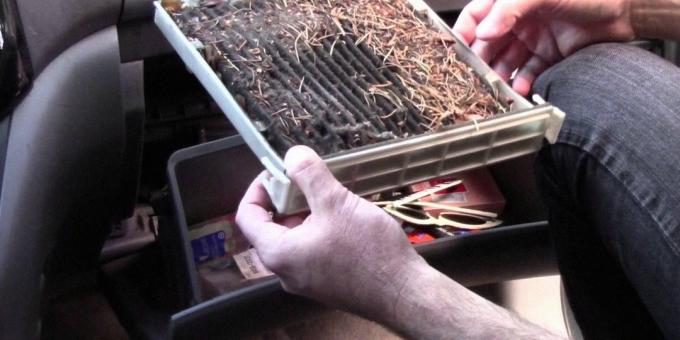
Sometimes the cause of bad working heater can be a dirty cabin filter or trapped because of his absence from the duct leaves, insects and dust. The heatsink then warmed but can not give heat from the weak air flow.
What to do
Check pollen filter and replace it if necessary. If no filter at all, although it should be, clean the air duct from the garbage. If possible, gain access to the radiator and heater well, blow it out with compressed air.
3. Faulty thermostat
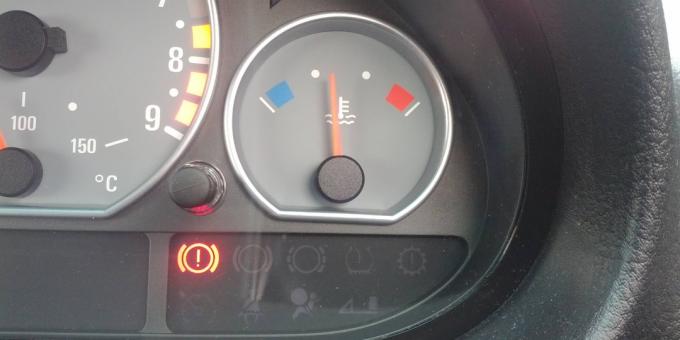
This is a common cause of problems with the stove. If klinit thermostat in a closed position, the breakage notice immediately, since in this case the motor overheats. But if we are talking about an open or half-open position, as a rule, the drivers know about it only with the advent of cold weather.
If the thermostat is always open, coolant is always moving in a large circle. As a result, the engine warms up very long, and sometimes it does not fully warmed up. Of course, neither of which the normal operation of the heater can be no question. This increases fuel consumption, as in the case of an automatic transmission also slows its warm-up time.
Symptoms thermostat are more or less tolerable heating stove when driving at low speed and cold air from the ventilation when driving on the road. The fact that the thermostat is always open, and indicates the simultaneous heating of both the radiator hoses. Normally, at engine start-up one must be warm, and the second - cold.
What to do
Only one option: replace the thermostat with a new.
4. Clogged heat exchanger

Another common cause. Typically, blockages occur due to poor coolant mixing different liquids, water filling or applying sealant to the cooling system. Deposits and scale to form inside the radiator, completely clog the cell and block the circulation of coolant.
What to do
Remove and change the radiator is difficult on any machine, so first of all try to wash it. You need a special tool or normal citric acid (100 g to dissolve in 5 liters of distilled water). With regular radiator hoses are removed, both input and output are connected others. The liquid was heated to 80-90 ° C and fed to the radiator by means of a pump.
Unfortunately, the washing is not a panacea. It helps about half the cases. In addition, due to the flushing of internal deposits can be formed to flow.
If flushing does not produce results, it will only replace the heat sink. In this case too, it is useful to completely wash out the entire cooling system and replace the fluid.
5. Wear pump impeller
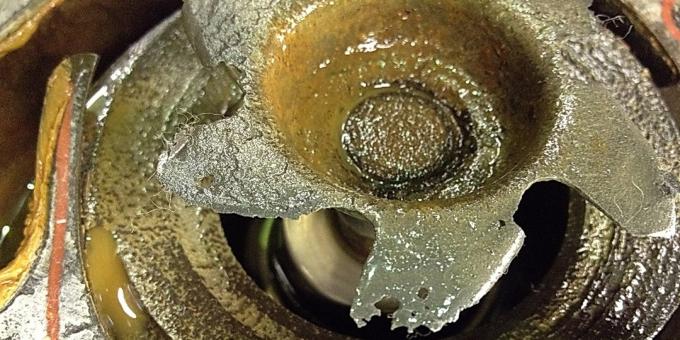
Pump - a pump that circulates the antifreeze from the engine, providing its continuous circulation on all nodes of the cooling system. Damage to the pump is difficult not to notice: in this case, the engine overheats and boils immediately.
When the impeller blades wear due to the aggressive action of water or antifreeze poor pump performance significantly drops. It still has enough to coolant circulated once and the engine does not overheat, but it is not enough for a full warm-up heater radiator.
What to do
Typically, the pump can not be repaired. Therefore, the problem is solved by replacing the defective unit to the next.
6. Problems with the fan

Cold in the cabin can be caused not only by lack of heating of the heater radiator, but his weak-blowing. This fan is already at fault, that does not provide the required air flow and heat dissipation from the heat sink.
What to do
If the fan is not working at all, everything is clear. More often it is spinning, but at an insufficient rate. This happens due to wear of the motor brushes or shimming bearings. In both cases you will need repairs in electrics.
7. Faulty valve actuator
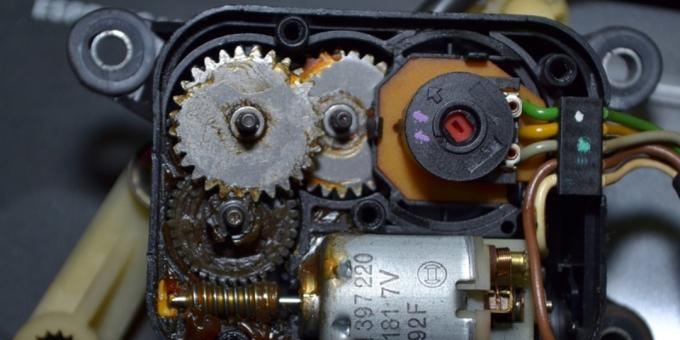
Another reason why the oven heats, but the heat in the interior does not reach, - a malfunction of the valve. All of the modern car heater radiator constantly heated and the heat from it goes only at open throttle duct. If the valve does not open or does not open fully, the optimal temperature can be no question.
The damper is driven via the servo, which is controlled by buttons on the handle or climate control panel. The problem may be either in breakage of the servomotor, and the slippage of ropes or rods, driving the flap.
What to do
Identify and correct this problem can only heater panel during disassembly. If jumped rods or cables, they must be put back into place. Faulty actuator, unless it is rejected completely, it would only be able to diagnose specialist. Repair of actuators to be rare, mostly the problem is solved by replacing the new one.
8. Breakage of the control unit heater

Moreover, the choke valve can not be opened due to faults in the climate control unit or temperature sensor. In this case, the desired signal is simply fed to the actuator that in turn does not open the valve, and in the cabin instead of hot goes cold air.
What to do
To determine the exact cause of the failure can only be a specialist after disassembling and diagnostics. Therefore, without a trip to a good car service to manage it is unlikely to succeed.
9. Leakage heater housing and the displacement of the radiator
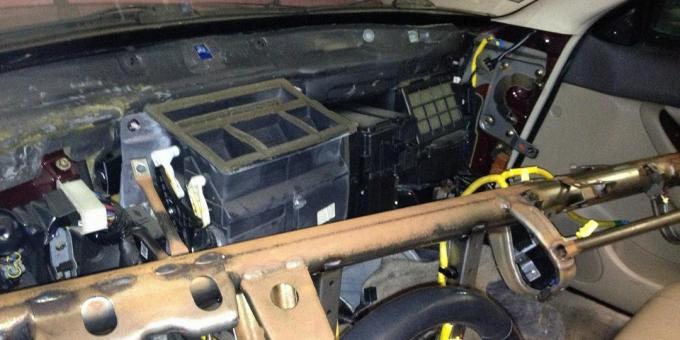
Fairly rare problem - a violation of the integrity of the housing. after an accident or incorrect assembly fuser plastic parts may be damaged or have gaps through which the hot air will go. In this case, the heater efficiency is greatly reduced.
In some cars due to weak latches or other design flaws radiator can be displaced from his seat, and the air blowing fan will not take place through it and past. The same thing happens when the duct damper is closed, that is, no it is not necessary to speak about any warmth.
What to do
In both cases it is necessary to disassemble the dash to get to the heater and restore normal operation. Ie to fix the damage, seal the joints of the body parts, return to the place of the heater radiator and well fix it.
With this you can handle on its own, but the work is not easy. Therefore, if you are not confident in their abilities, consult a specialist.
10. The breakdown of the cylinder head gasket
The most troublesome problem that, fortunately, quite rare. Due to engine overheating and poor tightening the cylinder head at some point may damage the gasket under it. If the breakdown happens between the cooling jacket and the combustion chamber, the gases from it will fall into antifreeze, forming bubbles, and deteriorating circulation, and in some cases even creating air traffic jams.
Recognize sample pads can be of dense white smoke, and more specifically - a pair of muffler which is formed by contact of the coolant into the cylinder. The expansion tank with air will boil, but because pressurized boil-off and may even antifreeze splashing outwardly.
What to do
Joke this is not necessary. At the slightest suspicion of the sample cylinder head gasket is better to immediately turn to the motorists. If you do not fix the problem in a timely manner, it may result in more serious malfunctions and expensive engine repairs.
see also🧐
- 50 steep avtolayfhakov on all occasions
- Should I include automotive air conditioning if the windows is less than zero
- 10 life hacking for safe winter driving



